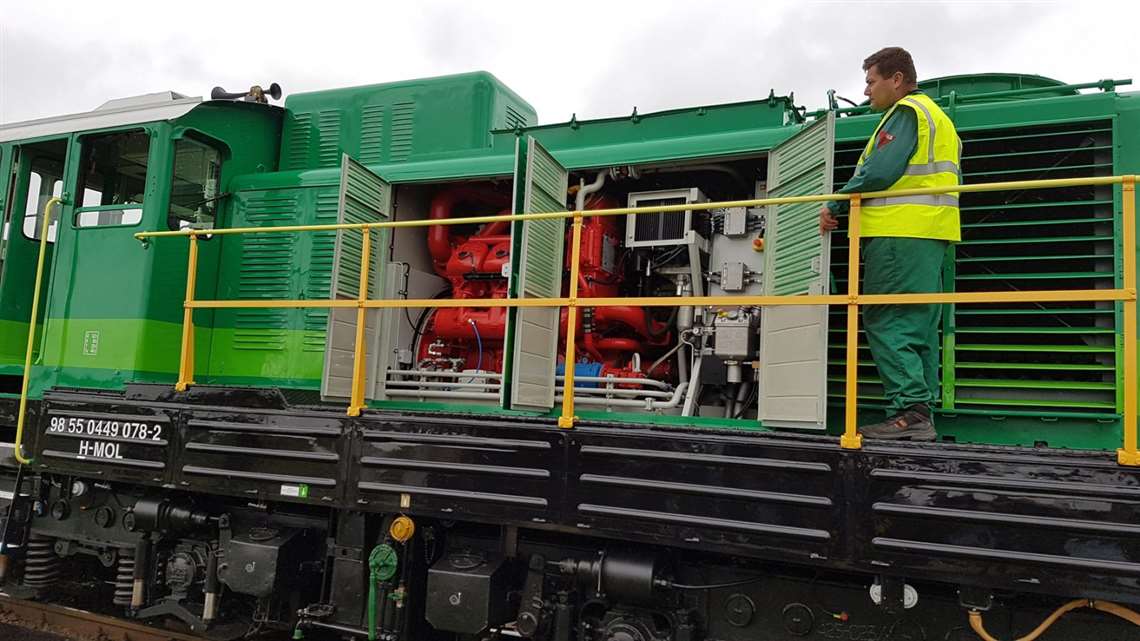Common Rail Goes Locomotive
27 February 2018

Heinzmann, a system provider for the management of combustion engines, generators and turbines, said it has successfully installed a common rail fuel injection system on a diesel engine for locomotives.
The engine is a GM185V-VG-CR from the Hungarian engine manufacturer Ganz Motor Kft., and is the re-engineered version of the S.E.M.T. Pielstick PA4V 185VG engine family.
According to Heinzmann, these typical high-speed diesel engines offer a wide power range depending on the number of cylinders. They are produced on a worldwide scale by license and are used mainly in railway applications.
The target for the engine was to fulfill EU emissions standard Stage 3a and the compliance was met by applying the following components: a high-pressure pump, magnetic valve control, and injectors for a pre-chamber injection. With the addition of a diesel particulate filter (DPF), the engine now fulfills even emissions Stage 3b, the company said.
A first engine conversion was done by Ganz Motor Kft. by changing the charging system, turbochargers and aftercooler. The hydraulic governor was also replaced by an electronic one. These conversions resulted in a reduction of the specific fuel consumption by 5%.
Due to recent changes in emission standards, however, it was necessary for Ganz to do a second re-design and Heinzmann was chosen for the development of the first common rail system with pre-chamber injection.
The first prototype common rail system was installed on a 12-cylinder version and field tests with the engine installed on a locomotive of the Hungarian National Railway Co. were performed in 2017.

In a subsequent application, the system was adapted to a six-cylinder GM185V-VG-CR engine and successfully tested on the test bench, the company said. In the meantime, several engines have been equipped with common rail. They are operated in the Hungarian oil industry and further orders have already been placed.
The new injection system now offers engine manufacturers several opportunities of adjustment in injection timing as well as in injection duration, which can be done more precisely than with mechanical fuel injection systems. The specific fuel consumption has been reported as reduced by about another 1% so that the total fuel consumption is reduced by approximately 6%.
With the introduction of a common rail based new engine, Ganz decided to stay with the existing pre-chamber concept and injection pressure of maximum 800 bar. This was considered to be sufficient for this combustion chamber arrangement. That way, the fuel system load can be kept on a low level in order to ensure a longer component lifespan.
From the component side, the ICR-DS 200 injectors with pintle-type nozzles provide an efficient combustion process with lower emission values compared to the more common direct injection with a wide spray angle, the company said. Heinzmann’s HDP-K3 high-pressure pump provides the fuel pressure. The pump, as all other Heinzmann high-pressure pumps, uses the company’s proprietary crankshaft concept; compared to the more common camshaft arrangement it has advantages in high efficiency and a wide speed range combined with an outstanding lifespan, Heinzmann said. The pump is available with different plunger configurations in order to cover the different flow quantities for 12- up to 18-cylinder engines.
The high-pressure fuel piping system is equipped with fuel accumulators for every single cylinder bank and short pipes connect the accumulators with the injectors. In addition, the Rail Pressure Limiting valve RPLV-2S for overpressure protection and the rail pressure sensor are directly connected to the accumulators.
Heinzmann’s magnetic valve control, Dardanos MVC01-20, is used for fuel injection control. Besides the speed/load control, this unit provides the rail pressure control and a set of configurable input and outputs (I/O) for monitoring and protection. Comprehensive parametrization allows the control system to be configured to almost any application, the company said. The DcDesk software allows easy communication.
For typical locomotive applications, the engine control system Dardanos is extended by the locomotive control Pegasos. This system provides a flexible power supply, isolated I/O extensions, notch and traction control and further loco-related functions, the company said.
STAY CONNECTED




Receive the information you need when you need it through our world-leading magazines, newsletters and daily briefings.
POWER SOURCING GUIDE
The trusted reference and buyer’s guide for 83 years
The original “desktop search engine,” guiding nearly 10,000 users in more than 90 countries it is the primary reference for specifications and details on all the components that go into engine systems.
Visit Now
CONNECT WITH THE TEAM









